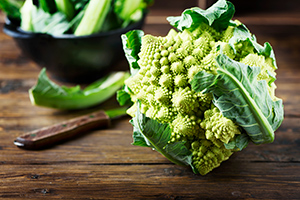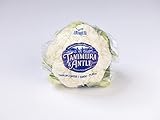Table of Contents
The cauliflower health benefits are many, but before we get into them, let’s first learn more about this fantastic food. The edible portion of the cauliflower is precisely its inflorescence (blossoms) before it fully flowers. It is formed of thousands of tiny buds. Botanically, cauliflower, broccoli, and all cabbages are varieties of the same species.
Farmers maintain the bright white of the cauliflower by binding the plant’s heavy outer leaves over the top, protecting it from sunlight. When sunlight reaches the buds, the result is cauliflowers in assorted colors depending on the type: green, like the Romanesque cauliflower, due to the presence of chlorophyll or purple caused by their anthocyanin content.
Cauliflower is a highly regarded vegetable and is eaten throughout the world. China is the world’s production leader, with an incredible one million metric tons annually.

Cauliflower Nutritional Facts
Cauliflower contains insignificant amounts of carbohydrates and proteins and no fat. It also contains provitamin A (beta-carotene) and vitamins B, C, and E, of which C stands out with 46.4 mg/100 grams. As for minerals, it is extraordinarily rich in potassium and low in sodium. It also contains significant amounts of calcium, magnesium, phosphorus, and iron.
Cauliflower is rich in trace elements such as chromium, zinc, manganese, copper, and selenium. These perform significant bodily functions, many of which are still being investigated. It is known, however, that these elements, well represented in cauliflower, provide vitality and energy to the body and help keep it healthy.
As with other crucifers, cauliflower is rich in phytochemical anticarcinogens, giving it cancer-preventative properties.
Cauliflower Health Benefits
The medicinal applications of cauliflower are as follows:

Digestive disorders – Cauliflower health benefits supplies vitamins, minerals, and trace elements that vitalize digestive processes. It works in the digestive tract, from the stomach to the colon. Because it is highly digestible, more so than other crucifers, it is preferred for those with stomach ailments (gastritis, ulcer, dyspepsia). It regulates transit through the intestine, both cases of constipation and diarrhea. Because of this, it is indicated for constipation, colitis, and diverticulosis. Cauliflower is, together with carrots and asparagus, one of the best vegetables for patients with acute gastritis or gastroenteritis.
Cardiovascular disorders – Its low sodium content, abundant potassium, and lack of fat make cauliflower one of the most effective foods for those suffering from heart or circulatory system disorders. It should be included in the diets of those with any form of heart disease, hypertension, or arteriosclerosis in any of their manifestations.
Obesity and diabetes—Cauliflower contains a minimum of calories: only 28 kcal/100 grams; however, it produces a sense of satiety. Boiled or steamed, cauliflower is the perfect supper for those wishing to lose weight and for individuals with diabetes due to its low carbohydrate content.

Kidney disorders – Cauliflower is a diuretic and depurant, facilitating the elimination of excess water retained in the tissues (edema) and waste materials such as urea. Its use is indicated in renal failure, arthritis, gout, edema related to renal issues, and kidney stones.
Cancer – Beginning in recent years, various experimental and statistical studies have demonstrated the anticarcinogenic effect of cauliflower, broccoli, cabbage, and other cruciferous plants. This effect is due to two types of phytochemicals: sulphurated glycosides and indole-derived compounds. Administrated orally, both substances can inhibit the formation of malignant tumors in laboratory animals previously treated with carcinogens such as benzopyrene.
Thus, significant use of cauliflower health benefits and other crucifers is indicated for persons at higher risk of cancer due to genetic predisposition, consumption of toxic substances such as tobacco, or other reasons. Those who have already been diagnosed with cancer and are in treatment should include some vegetables of the crucifer family, such as cauliflower, broccoli, cabbage, or radish, in their diet.
Warning
Although cauliflower health benefits are recommended for gastric and intestinal disorders, its use should be restricted in the following cases:
- Cholelithiasis (gallstones) since it can produce bile-related heaviness and dyspepsia.
- Intestinal flatulence – Cauliflower increases intestinal gas production in individuals with this propensity because of its cellulose content.
Cauliflower Scientific Facts

- Scientific name: Brassica oleracea L. var. botrytis
- French: Chou-fleur.
- Spanish: Coliflor, brécol de cabeza.
- German: Blumenkohl.
- Description: The inflorescence of the herbaceous plant of the botanical family Cruciferae.
- Environment: The cauliflower is from Mediterranean Europe, which still grows wild in some countries. It adapts well to cold climates, and its cultivation has spread to the five continents.
How to use and Prepare Cauliflower
- RAW – in a salad when young and tender.
- COOKED: boiled, steamed (the most healthful means of preparation), baked, fried, stewed, au gratin.
Frequently Asked Questions
What specific antioxidants are powerful in cauliflower, and how do they work?
Cauliflower health benefits boast several essential antioxidants:
1. Glucosinolates and isothiocyanates counteract harmful free radicals and are linked to potential cancer cell growth reduction.
2. Vitamin C: This well-known antioxidant supports immune function and may decrease heart disease and cancer risk.
3. Carotenoids and Flavonoids: These antioxidants have anti-inflammatory and potential anti-cancer effects
I’ve heard cauliflower health benefits aids digestion. How does this work?
Cauliflower is packed with fiber, crucial for gut health. Fiber promotes regular bowel movements and feeds beneficial gut bacteria, which is linked to reduced inflammation and improved immunity.
Can cauliflower help with weight loss?
Yes! Cauliflower is a weight-loss superstar for several reasons:
1. Low-calorie density: You get a satisfyingly large volume for a few calories.
2. High fiber: Fiber promotes a feeling of fullness, potentially helping you eat less overall.
3. Versatile low-carb substitute: Cauliflower can be “riced” or mashed, replacing higher-carb foods like rice and potatoes.
Does cauliflower have any impact on heart health?
Potentially! Cauliflower’s sulforaphane may help lower cholesterol levels, keeping arteries healthy and blood pressure in check. Additionally, fiber also supports cholesterol management.
Are there specific cancers that cauliflower health benefits may help prevent?
While more research is needed, studies suggest cauliflower’s components (particularly glucosinolates and isothiocyanates) may reduce the risk of certain cancers, including:
1. Breast cancer
2. Colon cancer
3. Lung cancer
4. Prostate cancer
Does the way I cook cauliflower change its health benefits?
It can! Here’s a quick guide:
1. Steaming/Microwaving: Best for preserving nutrients.
2. Roasting: This can enhance flavor, but some nutrient loss may occur at high temperatures.
3. Frying: Adds unhealthy fats and calories, negating many of cauliflower’s health benefits.
I’m concerned about pesticides. How can I get the most cauliflower health benefits with minimal risk?
Here are your options:
1. Buy organic: Reduces pesticide exposure.
2. Wash thoroughly: Even organic produce should be washed before eating.
3. Choose frozen: Frozen cauliflower is often flash-frozen at peak freshness, preserving nutrients, and may have less pesticide residue.
Do cauliflower health benefits include any anti-aging properties?
Cauliflower’s antioxidants may indirectly aid in anti-aging by helping protect your cells from damage that contributes to aging.
Are there any downsides to eating a lot of cauliflower?
For most people, no. However, excessive cauliflower intake can cause gas and bloating in some individuals.
Are there people who absolutely should NOT eat cauliflower?
Consult your doctor if you:
1. Take blood thinners (Cauliflower’s high vitamin K content may interfere)
2. Have thyroid issues (Discuss with your doctor as cruciferous vegetables can impact iodine absorption)
DISCLAIMER: All content on this website is presented solely for educational and informational objectives. Do not rely on the information provided as a replacement for advice, diagnosis, or treatment from a qualified medical expert. If you are pregnant, nursing, or have any preexisting medical concerns, talk to your doctor before using any herbal or natural medicines.
REFERENCES
- George D. Pamplona-Roger, M.D. “Encyclopedia of Foods and Their Healing Power.” George D. Pamplona-Roger, M.D. Encyclopedia of Foods and Their Healing Power. Trans. Annette Melgosa. Vol. 2. Chai Wan: Editorial Safeliz, 2005. 154, 155, 156. Print. [Cauliflower health benefits]
- https://www.health.com/nutrition/cauliflower-benefits
- https://www.webmd.com/food-recipes/health-benefits-cauliflower
- https://www.healthline.com/nutrition/benefits-of-cauliflower
Last update on 2024-07-23 / Affiliate links / Images from Amazon Product Advertising API





